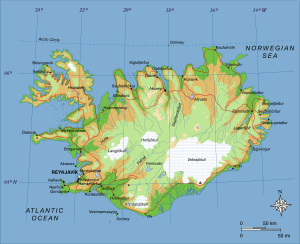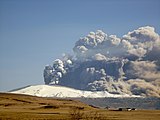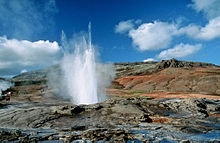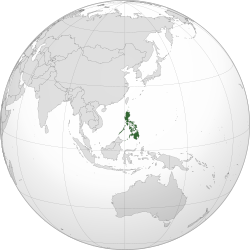This is Part 2 of Iceland : Land of
Extremes. It features sites like Gullfoss, Geysir, Blue Lagoon, Myvatn,
Dettifoss, Dynjandi, Surtshellir (lava tube cave), Jokulsarlon (iceberg
lagoon), a Viking Village and many others. Iceland is a fantastic
vacation destination for anyone seeking adventure and breathtaking
scenery.
CONT: From SCUBA Diving in Iceland~
Kingdom of Iceland 1918–1944
The
Danish-Icelandic Act of Union,
an agreement with Denmark signed on 1 December 1918 and valid for 25
years, recognized Iceland as a fully sovereign state in a
personal union
with Denmark.
The Government of Iceland established an embassy in
Copenhagen and requested that Denmark should handle Icelandic foreign
policy; Danish embassies around the world would display two coats of
arms and two flags: those of the Kingdom of Denmark and those of the
Kingdom of Iceland.
During World War II, Iceland joined Denmark in asserting neutrality. After the
German occupation of Denmark
on 9 April 1940, the Althing replaced the King with a regent and
declared that the Icelandic government should assume the control of
foreign affairs and other matters previously handled by Denmark.
A month
later, British armed forces
invaded and occupied the country, violating Icelandic
neutrality.
In 1941, the occupation of Iceland was taken over by the United States
so that Britain could use its troops elsewhere, an arrangement
reluctantly agreed to by the Icelandic authorities.
Independent republic 1944–present
On 31 December 1943, the
Danish-Icelandic Act of Union
expired after 25 years. Beginning on 20 May 1944, Icelanders voted in a
four-day plebiscite on whether to terminate the personal union with
Denmark, abolish the monarchy, and establish a republic. The vote was
97% in favor of ending the union and 95% in favor of the new
republican constitution.
[26]
Iceland formally became a republic on 17 June 1944, with
Sveinn Björnsson as its first president.
In 1946, the Allied occupation force left Iceland, which formally became a member of
NATO on 30 March 1949, amid
domestic controversy and riots. On 5 May 1951, a defense agreement was signed with the United States. American troops returned to Iceland, as the
Iceland Defence Force, and remained throughout the
Cold War; the US withdrew the last of its forces on 30 September 2006.
Iceland had prospered during the war, and the immediate post-war period was followed by substantial
economic growth, driven by industrialization of the fishing industry and the
Marshall Plan
programme, through which Icelanders received by far the most aid per
capita of any European country (at USD 209, with the war-ravaged
Netherlands a distant second at USD 109).
[27][28]
The 1970s were marked by the
Cod Wars —
several disputes with the United Kingdom over Iceland's extension of
its fishing limits. The economy was greatly diversified and liberalised
when Iceland joined the
European Economic Area in 1994.
Iceland hosted a
summit in Reykjavik in 1986 between United States President
Ronald Reagan and Soviet Premier
Mikhail Gorbachev,
during which they took significant steps toward nuclear disarmament.
Only a few years later, Iceland would become the first country to
recognize the independence of
Estonia,
Latvia, and
Lithuania as they
broke away
from the USSR.
Throughout the 1990s, the country expanded its
international role and developed a foreign policy that was oriented
toward humanitarian and peacekeeping causes. To that end, Iceland
provided aid and expertise to various NATO-led interventions in
Bosnia,
Kosovo, and
Iraq.
[29]
Rise and fall of Iceland as a financial center
In the years 2003–2007, following the privatization of the banking sector under the government of
Davíð Oddsson,
Iceland moved from being a nation best known for its fishing industry
toward having an economy based on financial services and investment
banking.
[30]
It was quickly becoming one of the most prosperous countries in the world before getting hit hard by a
major financial crisis.
[30] The crisis resulted in the greatest migration from Iceland since 1887, with a net emigration of 5,000 people in 2009.
[31]
Iceland's economy has since stabilized under the government of
Jóhanna Sigurðardóttir, and grew by 1.6% in 2012
Geography
Iceland is located at the juncture of the North Atlantic and Arctic Oceans. The main island is entirely south of the
Arctic Circle, which passes through the small Icelandic island of
Grímsey off the main island's northern coast.
The country lies between latitudes
63° and
67° N, and longitudes
25° and
13° W.
Although Iceland is closest to
Greenland (
North America), it is closer to
continental Europe
than to mainland North America; thus, the island is generally included
in Europe for historical, political, cultural, and practical reasons.
Geologically the island includes parts of both continental plates. The
closest body of land is Greenland (290 km (180 mi)). The closest bodies
of land in Europe are the
Faroe Islands (420 km (260 mi));
Jan Mayen Island (570 km (350 mi));
Shetland and the
Outer Hebrides, both about 740 km (460 mi); and the Scottish mainland and
Orkney, both about 750 km (470 mi). The mainland of Norway is about 970 km (600 mi) away.
Iceland is the
world's 18th largest island, and Europe's second largest island after Great Britain. The main island is 101,826 km
2 (39,315 sq mi), but the entire country is 103,000 km
2 (39,768.5 sq mi) in size, of which 62.7% is
tundra.
There are thirty minor islands in Iceland, including the lightly populated
Grímsey and the
Vestmannaeyjar archipelago. Lakes and glaciers cover 14.3% of its surface; only 23% is vegetated.
[33]
The largest lakes are
Þórisvatn (
Reservoir): 83–88 km
2 (32.0–34.0 sq mi) and
Þingvallavatn: 82 km
2 (31.7 sq mi); other important lakes include
Lagarfljót and
Mývatn.
Jökulsárlón is the deepest lake, at 248 m (814 ft).
[34]
Geologically, Iceland is part of the Mid-Atlantic Ridge, a ridge along which the
oceanic crust spreads and forms new oceanic crust. This part of the mid-ocean ridge is located above a mantle plume, causing Iceland to be
subaerial (above the surface of the sea). The ridge marks the boundary between the
Eurasian and
North American Plates, and Iceland was created by
rifting and
accretion through volcanism along the ridge.
[35]
Many
fjords punctuate Iceland's 4,970 km long coastline, which is also where most settlements are situated.
The island's interior, the
Highlands of Iceland, is a cold and uninhabitable combination of sand, mountains and
lava fields. The major towns are the capital city of Reykjavik, along with its outlying towns of
Kópavogur,
Hafnarfjörður and
Garðabær, nearby
Reykjanesbær where the international airport is located, and the town of
Akureyri in northern Iceland.
The island of Grímsey on the Arctic Circle contains the northernmost habitation of Iceland.
[5] Iceland has
three national parks:
Vatnajökull National Park,
Snæfellsjökull National Park, and
Þingvellir National Park.
[36] The country is considered a "strong performer" in environmental protection, having been ranked 13th in
Yale University's Environmental Performance Index of 2012.
[37]
-
Iceland, as seen from space on 29 January 2004
-
-
-
Geology
A geologically young land, Iceland is located on both the
Iceland hotspot
and the Mid-Atlantic Ridge, which runs right through it. This location
means that the island is highly geologically active with many volcanoes,
notably
Hekla,
Eldgjá,
Herðubreið and
Eldfell.
[38]
The volcanic eruption of Laki in 1783–1784 caused a famine that killed nearly a quarter of the island's population;
[39]
the eruption caused dust clouds and haze to appear over most of Europe
and parts of Asia and Africa for several months afterward.
[40]
Iceland has many
geysers, including
Geysir, from which the English word is derived, and the famous
Strokkur,
which erupts every 5–10 minutes. After a phase of inactivity, Geysir
started erupting again after a series of earthquakes in 2000.
Geysir has
since then grown quieter and does not erupt often.
With the widespread availability of
geothermal power, and the harnessing of many rivers and waterfalls for
hydroelectricity, most residents have access to inexpensive hot water, heating and electricity. The island itself is composed primarily of
basalt, a low-
silica lava associated with
effusive volcanism as has occurred also in
Hawaii. Iceland, however, has a variety of volcanic types (composite and fissure), many producing more evolved lavas such as
rhyolite and
andesite. Iceland has hundreds of volcanoes within approx. 30 volcanic systems active.
[41]
Surtsey, one of the youngest islands in the world, is part of Iceland. Named after
Surtr, it rose above the ocean in a series of volcanic eruptions between 8 November 1963 and 5 June 1968.
[5] Only scientists researching the growth of new life are allowed to visit the island.
[42]
On 21 March 2010, a
volcano in Eyjafjallajökull in the south of Iceland erupted for the first time since 1821, forcing 600 people to flee their homes.
[43] Further eruptions on 14 April forced hundreds of people to abandon their homes.
[44] The resultant cloud of
volcanic ash brought
major disruption to air travel across Europe.
[45]
Another large eruption occurred on 21 May 2011. This time it was the
Grímsvötn volcano, located under the thick ice of Europe's largest glacier,
Vatnajökull.
Grímsvötn is one of Iceland's most active volcanoes and this eruption
was much more powerful than the 2010 Eyjafjallajökull activity. The
eruption hurled ash and lava 20 km (12.43 mi) up into the atmosphere,
creating a large cloud that for a while was thought to pose a danger to
jet aircraft over a wide area of
northern Europe.
Source: Wikipedia Again there is just to much information to post it all here. Check It Out! It is very interesting It is a shame I didn't make the time to see more of It when I had the chance.
TTFN
Thanks for Wwatching.












![Location of Iceland (dark green)in Europe (dark grey) — [Legend]](http://upload.wikimedia.org/wikipedia/commons/thumb/6/66/Europe-Iceland.svg/250px-Europe-Iceland.svg.png)








